|
 |
|
 |
| |
YEREVAN |
|
 |
|
 |
| |
Категория: Itineraries |
Новость от: admin | 15.03.2007, 06:57
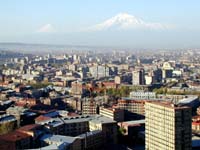
Yerevan- the Capital of Armenia is one of the most ancient cities of the world. Having visited Yerevan, you can see a lot of interesting and surprising. There are many museums in Yerevan among them such as the Historical museum, the Picture Gallery of Armenia, the Museum of Modern Art, house - museums of Saryan, Parajanov, Tumanyan, Spendiarov and others. Matenadaran is a unique library of ancient manuscripts, where more than sixteen thousand Armenian manuscripts of different volume and age are stored.
The squares of Yerevan are beautiful and original in particular. The Republic Square was built up of monumental, deeply national structures surrounding the square site. Here the governmental buildings, hotel "Armenia", a building housing the Picture Gallery, museums are situated. Overlooking the square, on the wall of the House of the Government, there is a city chiming -clock. The building has national colour. Columns and arches on the facades of the buildings are richly decorated with thin carving featuring the motives of ancient Armenian ornament . All other buildings on the square are subordinated to the general plan. Here, there is a fountain with a song of lumiere. The small boulevard adjoins to the square where 2750 small fountains were placed in 1968, in commemoration of the historic age of the City of Yerevan
The building of the Opera and Ballet Theatre after Spendiarov, the Sport and Concert Complex, the Palace of Youth, the House of the Chess Player, the Academy of Sciences, Matenadaran, University, numerous theatres, cinemas, hotels are all eye-catching with their beauty.
|
|
 |
|
 |
 |
|
 |
| |
ZVARTNOTS |
|
 |
|
 |
| |
Категория: Itineraries |
Новость от: admin | 15.03.2007, 06:53
.jpg)
ZVARTNOTS is the most majestic construction of church architecture of Armenia. It was one of the wonders of its time. ZVARTNOTS took deserved place among the number of great phenomena and for ever remained in the history of universal culture for its high architectural art, impudence of idea and boldness of performance. It was constructed in 652 in the time of Nerses Catholicos on the place of a meeting between king Trdat and the first preacher of Christianity freed from the fifteen-year captivity - GREGORY the ILLUMINATOR. The temple stood until X century, but in the result of devastating earthquake in 930, this unique construction was destroyed. Prior to the beginning of the XX century on this place there were only small deserted hills with the shapeless remnants of constructions. It was possible to guess only from the books of our historians that the temple constructed here in VII century "was buried". At the beginning of the XX century a group of archeologists carried out big excavation. Architect Toromanyan supervised over these works. Unfortunately, none of historians left a concrete description of the temple. Numerous praises of eyewitnesses were kept only. The architect managed to recreate a composition of the temple only on the basis of measurements and laborious studying of each architectural detail. Construction appeared to be unusual to Armenia. Many doubted of the correctness of Toromanyan. But during the very time, unexpectedly, another expedition excavated a stone statue of one of the Armenian kings (Gagik). There was a breadboard model of church in his hands, which resembled like two peas in a pod a breadboard model represented by Toromanyan. So the assumptions of the architect were confirmed. As to Тоromanyan the building consisted of three polyhedrons, put against each other, and decreasing in diameter and height. They were finished with a cone of a dome. The walls of construction outside were polyhedral, from within - completely round. From outside the walls were decorated by 64 semi columns, between which doors and oblong windows were placed.
|
|
 |
|
 |
 |
|
 |
| |
KHOR- VIRAP |
|
 |
|
 |
| |
Категория: Itineraries |
Новость от: admin | 15.03.2007, 06:49
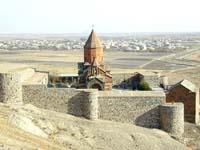
KHOR-VIRAP is a monastic fortress of XVII century located on a hill. According to legends here was situated the ancient Artashat , and its prison was on the place of the present church. The prisoners were thrown into the holes teeming with snakes, poisonous insects . GREGORY the ILLUMINATOR was put into prison without time limit at the end of III century in one of these holes for propagating Christianity. He was punished by the pagan king Tiridat for his convictions. Gregory had been under the sentence for long years. According to legends during all these years a woman brought him meal, and the god gave him strength of mind. The legend goes that after 13 years of the imprisonment of the righteous person in a hole, Tiridat came down with a severe disease. The vision came on to the king informing, that only Gregory will rescue him. The king ordered to release the captive from the prison and bring him to Vagharshapat. The prediction came true; the king recovered and justified the prisoner. So the former captive who is an example of stability, a sample of the person not changing his confession, became the founder of the Armenian Christian Church, and Trdat having accepted Christianity, became the first Christian king of Armenia.
|
|
 |
|
 |
 |
|
 |
| |
TATEV |
|
 |
|
 |
| |
Категория: Itineraries |
Новость от: admin | 15.03.2007, 05:23
.jpg) High up in mountains of Zangezur - in one of the scenic corners of Armenia - powerful, unapproachable and stronghold monastery of Tatev towers on the high rock rising above the deep gorge. It was founded in IX century on the place of an ancient sanctuary. High up in mountains of Zangezur - in one of the scenic corners of Armenia - powerful, unapproachable and stronghold monastery of Tatev towers on the high rock rising above the deep gorge. It was founded in IX century on the place of an ancient sanctuary.
Its beneficial strategic location favoured creation of powerful fortifications here.
Thick fortifications protected this monastic small town, standing for twelve centuries and vulnerable to the earthquake only. Tatev was built up from IX to XVIII century, but the majority of its constructions were erected in XIII century. The monastery of Tatev was not only the religious, but also the political center of Syunik princedoms.
The St. Peter and Paul Cathedral served as the center of the monastery constructed in 895-906. It is a dome basilica. The annexes were in the western part of the building, whose wall corners serve for supporting the dome. The laconic shape of the temple strengthens the impression of significant height of the building. Smooth, without overly detailed works, the facades of the temple were decorated only with bas-reliefs featuring human faces confronting the heads of snakes worshipped by Armenians as patronesses of dwelling.
Inside the temple the walls were decorated with frescos which have been completely lost by now. In the altar part the Christ was represented accompanied with prophets and saints. On one of the walls there were paintings with the scenes of terrible court, on another one - scenes of Christmas.
The church of St. Grigor built in 1295 adjoins to the southern wall of the main temple, where an earlier construction of IX century used to stand. The architecture of the building is simple- a rectangular hall overlapped by the cylindrical arch. The walls are not blocked up with a carved pattern. Only original form of the windows in the form of two crosses with half columns between them is allocated. But the portal of the construction is framed by openwork carving with a fine and intricate pattern. Before the entrance to the main temple, in XIX century the three-storied bell tower with light octagonal belfry was built .
|
|
 |
|
 |
 |
|
 |
| |
SPITAKAVOR |
|
 |
|
 |
| |
Категория: Itineraries |
Новость от: admin | 15.03.2007, 05:21
.jpg)
The monastic complex of SPITAKAVOR is not far from the town of Eghegnadzor. It is located in one of the picturesque corners of Armenia. The monastery is perched high up in unapproachable rocks. It is surrounded with deep gorges from all sides, along which the mountain rivers flow.
The ensemble consists of the church, vestibule and bell tower. It is surrounded with fencing.
The only church of the complex is the church of ASTVATSATSIN. It was built in 1318-1321. The church has a simple strict appearance. Above the entrance door there is a sculptural image of the St.Virgin. It is one of the best examples of the medieval art.
Inside the church there are many sculptural compositions with various plots. The composition representing a prince with his son (which nowadays is in the Hermitage) is remarkable. The composition representing scenes of hunting is quite appealing But especially attractive is the sculpture of the Christ surrounded with apostles.
|
|
 |
|
 |
 |
|
 |
| |
SEVAN |
|
 |
|
 |
| |
Категория: Itineraries |
Новость от: admin | 15.03.2007, 05:45
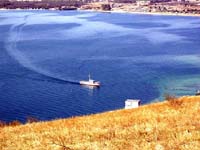
High up in the mountains is situated the pearl of Armenia - lake Sevan . The former name of the lake is the Geghama sea. It lies in the deep hollow surrounded with mountain ridges, at the height of 1897 meters above sea level. 28 rivers flow into it, and only Hrazdan flows out. It is difficult to describe the beauty of Sevan - you need to see it with your own eyes. But here it is possible to admire not only the beauty of the landscape. The surroundings of the lake are spotted with many historical monuments .
Sevan is a historical area to which its former name - Gegharkunik nowadays was returned. Here in II-I millennia B.C. were centered the fortresses serving both as administrative centres and strong points for Urartu garrisons . Many of these monuments are kept up to now. Let's familiarize ourselves with some of them.
At a distance of about 3 km off the coast, near the course of the river Hrazdan rose an uninhabited rocky island, which became peninsula due to the shallowing of the lake. Right at the end of VIII century monks settled here, who constructed a chapel and some cells. Then three churches, economic constructions and cells were erected of which the following churches have remained to now: St. Arakelots and St. Astvatsatsin, erected in 874, which are small crusade-dome constructions constructed of smoothly hewed stones.
|
|
 |
|
 |
 |
|
 |
| |
SARDARAPAT |
|
 |
|
 |
| |
Категория: Itineraries |
Новость от: admin | 15.03.2007, 05:55
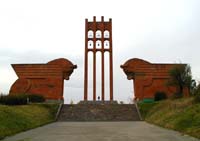
SARDARAPAT is the memorial ensemble devoted to the historical events, occurred at the beginning of XX century. In 1918 the turkish army intruded into Ararat valley, occupied the village Sardarapat and launched attack on Yerevan. On May 22, 1918 here took place the decisive battle against the enemy. Young and old, men and women, soldiers and volunteers,- all rose to avert the imminent danger at the cost of their lives. On May 26 the turkish regular army was completely crushed. In commemoration of 50-th anniversary of this historical fight in May, 1968 this wonderful architectural ensemble was opened according to the plan of architect Israelyan. The architecture of the monument is extraordinarily individual and consequently unique. This construction has no prototypes in the Armenian architecture. Here the architecture and sculpture are harmoniously entwined. The ensemble is built of red tuff. The high and beautiful bell tower - burial vault gives special originality to the complex. Its transparent ease is even more emphasized against the background of massive sculptures of winged bulls. The bell tower - burial vault ennobling on 4 bases, was constructed on the place of the burial site of the fighters fallen in the battle, and sacred bulls symbolizing survived participants of Sardaparat, are called to protect the gravestone - burial vault. An alley leads to other constructions of the complex on which sculptures of eagles, symbolizing bravery of heroes of the battle were erected.
|
|
 |
|
 |
 |
|
 |
| |
CAVE CITIES |
|
 |
|
 |
| |
Категория: Itineraries |
Новость от: admin | 15.03.2007, 05:06
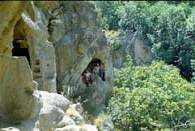
In the region of Goris (Syunik) there are interesting historical monuments - cave and rocky dwellings - so called karataks. The significant part of population of Syunik lived in them in the past. Numerous cave dwellings were, basically, in the gorges of the river Vorotan and its inflows. In the valley of the small river Vararak (Goris -get) there is a district of "Tsakeri-dzor" - the gorge of catacombs.
Most likely, the caves which are situated under firm covers of lavas were being formed in the result of washout of underlying softer and friable soils. People, finishing the cause of the nature, dug out and took out the ground; some of them plastered the walls with clay. Sometimes cave dwellings, with a view of protection, were made so high up in the precipice of the gorge, that it was difficult to reach them even for inhabitants: they climbed up keeping at the cord the end of which was attached to the threshold of the dwelling.
One of the cave cities is near the town of Goris. The houses were constructed here in the form of peaked, high (up to 40-50 meters) cones, mostly standing in groups. Each dwelling, as a rule,was divided by partition into two parts: tun - for residing people and gom - for cattle. Rocky apartments, as a rule, were without windows - they were illuminated only from the side of the entrance. Along the walls of dwelling part the big benches were cut down, and in goms - feeding troughs for cattle. Some of the caves were used as small pantries and barns. The cave city is many- tiered, and a roof of the bottom dwelling serves as an entrance platform for the upper dwelling. With the advent of metal instruments natural caves extended more and more and were reconstructed, forming rather big settlements.
|
|
 |
|
 |
 |
|
 |
| |
OSHAKAN |
|
 |
|
 |
| |
Категория: Itineraries |
Новость от: admin | 15.03.2007, 05:30
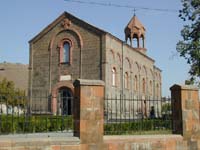
OSHAKAN - a small settlement situated not far from Yerevan. The first mention about Oshakan goes back to the first half of the IV century. Historians describe the battle between Persians and Armenians (which Armenians won), taken place in this settlement in 336.
However , monuments of earlier period were found in this territory.
On the hill of DIDI the remnants of urartu fortresses of VII-V centuries B.C. were found out. The fortress was constructed of large stones which have been cemented with lime. In the territory of the fortress there were many inhabited and auxiliary constructions. From five palace complexes were excavated only one entirely and a part of the second one. 40 rooms of a palace and a hall were excavated. In the territory of the complex the remnants of church were found out. Archeologists found many paraphernalia of ceramic , stone and bone, more than 100 statuettes. Here were found out burial places from III century B.C. . At excavation many tools, weapons, golden, silver and bronze ornaments were discovered. The current excavations show traces of the masonry of later period of the IV century A.D. on the walls of palaces . Hence we can gather that over centuries the palaces were completed and repopulated.
|
|
 |
|
 |
 |
|
 |
| |
NORAVANK |
|
 |
|
 |
| |
Категория: Itineraries |
Новость от: admin | 15.03.2007, 05:23
.jpg)
The monastery of Noravank is among freakish steep red rocks on a ledge of twisting gorge. It was based in XII century in the place of ancient constructions. In the times of princes Obelyans reign the monastery became a large religious center, and in XIV century - a residence of bishops of Syunik.
The most ancient church of the monastery is the Church of St. KARAPET, reached to us in ruins, constructed in IХ-X centuries. In the north of it, the main temple of the monastery also carrying the same name was erected in 1216-1223. This is a cross winged-dome building with two-storey vestries in four corners. The temple has strict decorative furniture. A vestibule was attached to the western side of the church in 1233, otherwise called Gavit or Zhamatun gravely damaged following the earthquake of 1321 and subsequently (1333) restored by the famous architect Momik.
Over the restoration of the dome the yerdik (the illumination aperture in the center of the overlapping) was reconstructed. Tympanum windows above the door were decorated with unique images of the god - father, blessing the crucified Christ, and semicircular tympanum of the entrance door - the image of the Blessed Virgin with the baby and the faces of two Saints directed to her. Inside the vestibule deep niches with cross stones were constructed.
|
|
 |
|
 |
 |
|
 |
| |
MATENADARAN |
|
 |
|
 |
| |
Категория: Itineraries |
Новость от: admin | 15.03.2007, 05:53
.jpg)
In the center of Yerevan, right at the end of the avenue bearing the name of great Мashtots the monumental building of grey basalt rises. It is MATENADARAN - the State Repository of ancient manuscripts. The building was erected in 1957, the evidence of which is four copper Armenian letters at the entrance on the floor. It was built in the spirit of traditions of national architecture of ХII-XIII centuries. In front of the building the monument to Mesrop Mashtots - the founder of the Armenian writing- was built. On both sides from the front entrance six more sculptures were established, among which are sculpture of the ancestor of historiography Movses Khorenatsy and outstanding scientist Ananya Shirakatsi.
On the wall the following words were engraved: " To learn wisdom and exhortation, to understand sayings of reason … " These were the first words traced on parchment with the newly created Armenian letters.
The interiors of Matenadaran were enriched with sculpture, ceramics, fresco and mosaic. All this creates impression of solemnity and simplicity.
In funds of Matenadaran more than 16 thousand manuscripts are kept and studied. This collection is constantly replenished with new finds, gains and gifts, which are flowing down from all over the world. The most part of manuscripts had skin bindings with a stamping; the part was made in silver frameworks. Parchments of manuscripts were richly decorated with a miniature that itself represents a work of art.
On the ground floor the repository of manuscripts is located. Here there are laboratories intended for work on manuscripts - their studying, restoration, photographing, etc.
On the upper floors studies of researchers, a reading room and a show room are located.
Pearl of Matenadaran are the works of the Armenian historians, mathematicians, astronomers, geographers, and doctors. Here there are both well-known code of laws of Mkhitar Gosh and verses of the well-known medieval poets. The best samples of manuscripts are shown in the show room.
|
|
 |
|
 |
 |
|
 |
| |
МАКАРАВАНК |
|
 |
|
 |
| |
Категория: Itineraries |
Новость от: admin | 15.03.2007, 04:32
.jpg)
The complex of Makaravank is near to the town of Idzhevan. It was constructed at the foot of the mountain Pajtatap on a high-mountainous plateau among dense woods.
The monastic complex of Mkaravank, together with historical castle Mahkanaberd represents one of the most significant monuments of architecture of the medieval Armenia as to riches of furnishings of monuments included in its ensemble, a great skill of stone-carving and exclusive harmonicity of the architectural group, skillfully placed into the marvellous mountaineos landscape. Monuments of Makaravank were constructed of dark pink and red stones. At the gate of the monastery water of a spring is flowing through ancient pipes up to day. Once the monastery was surrounded with impressive walls and extensive settlements were established nearby. The Makaravnk comlex comprises the following monuments.
The OLD church was constructed in X-ХII centuries. The building of the church is rectangular from outside and cruciform from within. It was constructed of red stone on mortar. The whole surface of the altar and the frame of window apertures is covered with the finest vegetative and geometrical ornament. The entrance to church through the annex is from the western part.
|
|
 |
|
 |
 |
|
 |
| |
JUKHTAKVANK and MOTOSAVANK |
|
 |
|
 |
| |
Категория: Itineraries |
Новость от: admin | 15.03.2007, 04:52
.jpg)
Monastery Jukhtakvank (Pair monastery) is not far from Dilijan town. It was constructed on the picturesque glade surrounded with woody slopes from all parts. The name of church originated from the quantity of churches in ensemble- jukht (pair). It is ST. GRIGOR and ASTVATSATSIN.
Church ASTVATSATSIN (VIRGIN) was constructed in 1201. This is a rectangular premise with vaulted covering under the gable roof, laid out with yellow stones. On the walls of the church remain many inscriptions . Another name of this church - temple ST. PETROS was mentioned on one of them.
Church SURB GRIGOR is a central dome building with four arches leaning on wall columns. This medium size building is laid of hewed stones. Its vestries are decorated with skilfully executed bas-reliefs notable for their good taste and perfection of performance. Church ST. GRIGOR was constructed earlier than ST. ASTVATSATSIN.
Below, in the gorge of the river Bldanchay, gushes out mineral spring "ttu- jur" (sour water). Right opposite the Jukhtakvank, on the other slope of the gorge, there is one more architectural complex - MOTOSAVANK. However to find Motosavank, despite simple orientation, it is rather difficult, as the high grass at the full height of the person and thrickets of a bush surrounding monuments with a dense wall, reliably hide it from extraneous eyes.
|
|
 |
|
 |
 |
|
 |
| |
GOSHAVANK |
|
 |
|
 |
| |
Категория: Itineraries |
Новость от: admin | 15.03.2007, 04:56
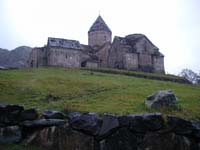
Near to Dilijan on a high plateau of a picturesque gorge a monastic complex of Goshavank is located. It is perfectly blended with in the nature surrounding it.
The ensemble was constructed on the place of the ancient Getik monastery destroyed in the result of the earthquake of 1188.
The incorporated monastery was originally called New-Getik. But as in its construction the outstanding politician and the scientist of medieval Armenia-Mkhitar Gosh had an active participation, after his death a monastery was renamed into Goshavank. Mkhitar Gosh was the author of the first Code of laws as well. He was also the author of numerous parables and fables.
Goshavank was one of the large centers of medieval culture of Armenia. In its territory worked an Academy - the higher spiritual school which had a legal and historical bias. Here were taught divinity, philosophy, rhetoric, drawing, caligraphy, music. At school studied many famous figures of spiritual culture who then opened schools in other monasteries , continuing their tradition.
The basic churches had identical appearance: from outside they had rectangular form, from within - cruciform. In their corners were located side-chapels. All of them were covered with identical domes.
Church ASTVATSATSIN (TheVirgin) was constructed in 1191-1196. The church originally was wooden, and then it was replaced by stone one.
|
|
 |
|
 |
 |
|
 |
| |
GARNY-GEGHARD |
|
 |
|
 |
| |
Категория: Itineraries |
Новость от: admin | 15.03.2007, 04:45
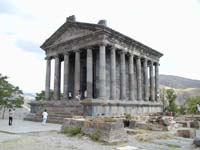
In Garny there is an architectural complex - a monument of culture of Armenia of antique epoch of its history (IV century BC - III century AD). The fortress of Garny was picturesquely settled down on a high rocky gorge. From three sides it is surrounded with deep canyons the walls of which are vertical rocks with steep and freakish stones. From the fourth, flat side, a 26 meters high powerful fortification, which was constructed from the large basalt blocks, connected with each other by the iron brackets filled with lead. 14 towers with loopholes were located on fortifications which communicated with each other.
GARNY in IV-III centuries B.C. served as a residence of Armenian kings. Palace buildings were situated in the southern part of the fortress. Here there were also front doors apartments for the kings, both palace church, and premises, and a bath. The imperial Palace was two-storey. It occupied the area of 15х40 meters. Its smart hall (10х20 m), was decorated with numerous columns. Walls of the premise were richly painted by color plaster. As the result of excavation, in the territory of the palace, fragments of various sculptures, subjects of a palace life, and details of architectural ornaments were found. Not far from the palace there was a front door hall where solemn ceremonies were carried out. The visitors were received here. Nearby a bath dating from the III century was located. It consisted of five rooms: cloak room, bathing hut, both with hot and cold water, furnace premises with the tank for heating water. Up to now has survived the mosaic containing various plots by which floors of premises were covered. For example, the plot of a mosaic in the cloakroom was taken from the Greek mythology. The gods of Ocean and Sea accompanied with Nereids and fishes were represented. The inscriptions in the Greek were kept as well.
|
|
 |
|
 |
 |
|
 |
| |
EREBUNY |
|
 |
|
 |
| |
Категория: Itineraries |
Новость от: admin | 15.03.2007, 04:36
.jpg)
In 782 B.C. at the top of Arin - Berd hill the following inscription was engraved" God Khaldi with greatness of Argishti, the son of Menua, constructed this powerful fortress and established for it the name EREBUNY, for power of Biajlini country and for intimidation of the enemy countries". This inscription informs of a place and time of the foundation of a fortress that denominated settlement - EREBUNY - YEREVAN. The ruins of Erebuny city, or rather its citadels, are located on Arin - Berd hill, situated in the southeast surburb of Yerevan.
Erebuny was one of the important administrative and strategic centers of Urartu state, well adapted to long defense. The citadel has been provided with gravity water pipe and made in powerful three-row fortifications in height of about 10 meters. In the territory of100 hа the ruins of the most ancient city constructions and citadels are visible. Arin-Berd citadel is preserved so well, that the escaped walls up to the height of 3-4 meters quietly outlined its general plan with smart halls, the spiritual premises and open palaces. The biggest structures of the citadel were the palace of king Argishti, hall of columns intended for official smart receptions and solemn ceremonies, temples of gods Khaldi and Susy. Walls of these constructions were covered with the refined frescos with a remarkable combination of bright colours. Plots of paintings had also the spiritual content (procession of gods, sacred animals, the tree of lives), as well as the secular character (images of the person and animals, a hunting scene). In different premises of citadel colorful frescos with original urartu times lions and ornaments from the geometrical figures performed with exclusive skill were found out. The pantry with traces of huge pitchers - clay vessels for storage of grain, oil, vine and other products was discovered.
|
|
 |
|
 |
 |
|
 |
| |
ECHMIADZIN |
|
 |
|
 |
| |
Категория: Itineraries |
Новость от: admin | 15.03.2007, 04:16
.jpg)
Echmiadzin is not far from Yerevan. This place is worshipped by Armenians throughout the world since here there is the Mother See of Armenian Apostolic Church.
Echmiadzin -formerly Vagarshapat, was founded in the first half of II century on the place of ancient settlement of Vardgesavan. Since 163, after destruction of Artashat by Romans, the city had become political, cultural, and then religious and educational center of the country.
In 301 the Christianity became the state religion of Armenia. According to a legend, the first patriarch Gregory the Illuminator dreamt, that the only begotten, that is the Christ, came down from the sky with fiery hammer in hands and specified the place for construction of the cathedral. On this place in 303, in place of an ancient pagan temple, the church named ECHMIADZIN was founded which in Armenian means " the place of the advent of the only son".
As Armenia frequently lost statehood the role of the Supreme religious head of all Armenians Katholicos- grew ever more. Therefore the cathedral of Echmiadzin as the most constant center of spiritual authority of the country, though frequently destructed, but also equipped with modern conveniences more than other monasteries.
|
|
 |
|
 |
 |
|
 |
| |
AGHDZQ (DZORAP) |
|
 |
|
 |
| |
Категория: Itineraries |
Новость от: admin | 15.03.2007, 04:24
.jpg)
Not far from Byurakan there is a village AGHDZQ, where there is a unique construction of IV century - a tomb of the Armenian kings.
Before visiting the monument let's recall events of the beginning of the first millennium, occurring in Armenia in the last years of an independent Armenian empire. Soon Armenia was divided between great powers of the world of those times - Byzantium and Persia. Persians moved ahead deep into the country, spreading horror and ruin everywhere. Here they besieged fortress Ani and took out countless treasures. They even dug out the tombs of the Armenian kings in Tigranakert and took away with them their bones, they thought that together with the remnants of the Armenian kings their glory and their bravery went to their country. But having learned about it, the Armenian army attacked Persians and rescued the remnants of the Armenian kings. They were brought to village ALDZIK (nowadays AGHDZQ) and were reburied there. A tomb is constructed for this purpose. This construction is dated from 359 - 360.
|
|
 |
|
 |
 |
|
 |
| |
DADIVANK |
|
 |
|
 |
| |
Категория: Itineraries |
Новость от: admin | 15.03.2007, 04:12
.jpg)
Monastery of Dadi or Khut is one of the majestic monuments of the Armenian architecture. It was constructed on a hill, towering above the mountain valley, at the bottom of Karabakh and Mrov ridges.
In V century the temple became residence of Aghvan bishop, and then one of the important cultural and educational centers of this region.
All constructions of the monastery, and they are more than ten, are located on the slopes of the hill.
The legend says, that the monastery was constructed back in the middle of I century on the place of burial of one of the disciples of apostle Fadey (Tadey) - Dadi which was martyrized in Artsakh for propagating Christianity.
Constructions of a monument, basically, are preserved quite well.
According to historians the monastery was inhabited with a plenty of people. It was repeatedly devastated, plundered by Persians, Arabs, Seljukes, Osman Turks. Since XVII century Dadivank had constantly lost its territories and inhabitants of the villages belonging to the monastery, had violently resettled from familiar spots. And already in the middle of XIX century only ruins remained from the monastery.
In the northern part of the monument there is an ancient church of the monastery. Strict appearance of church hardly softens the platbands of entrances covered with ornament.
The second church is also rather ancient and adjoins to the first one. It is significantly narrower and shorter than the first church. Its prayer hall is divided by an internal wall into two equal parts. One of them, most likely, served as a vestibule.
The prosperity of the monastery fell on the XIII century.
|
|
 |
|
 |
 |
|
 |
| |
AGHARTSIN |
|
 |
|
 |
| |
Категория: Itineraries |
Новость от: admin | 15.03.2007, 04:33
.jpg)
Monastery of Dadi or Khut is one of the majestic monuments of the Armenian architecture. It was constructed on a hill, towering above the mountain valley, at the bottom of Karabakh and Mrov ridges.
In V century the temple became residence of Aghvan bishop, and then one of the important cultural and educational centers of this region.
All constructions of the monastery, and they are more than ten, are located on the slopes of the hill.
The legend says, that the monastery was constructed back in the middle of I century on the place of burial of one of the disciples of apostle Fadey (Tadey) - Dadi which was martyrized in Artsakh for propagating Christianity.
Constructions of a monument, basically, are preserved quite well.
According to historians the monastery was inhabited with a plenty of people. It was repeatedly devastated, plundered by Persians, Arabs, Seljukes, Osman Turks. Since XVII century Dadivank had constantly lost its territories and inhabitants of the villages belonging to the monastery, had violently resettled from familiar spots. And already in the middle of XIX century only ruins remained from the monastery.
In the northern part of the monument there is an ancient church of the monastery. Strict appearance of church hardly softens the platbands of entrances covered with ornament.
The second church is also rather ancient and adjoins to the first one. It is significantly narrower and shorter than the first church. Its prayer hall is divided by an internal wall into two equal parts. One of them, most likely, served as a vestibule.
|
|
 |
|
 |
 |
|
 |
| |
ANI |
|
 |
|
 |
| |
Категория: Itineraries |
Новость от: admin | 15.03.2007, 04:19
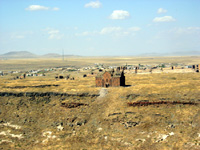
The most beautiful, magnificent, the richest … It is possible to characterize the pearl of the East with such words - the city of ANI, which was in the limelight for long years, due to its exclusive beauty and grandeur. Even now,when only ruins of the city areleft, it continues to be admired by everyone.
The city of Ani is located on the high bank of one of the tributaries of the river Akhuryan.
The first mention of city dates from the V century. Historians mention the unapproachable fortress located on the rock, and named Aghchkaberd. However, till VIII century Аni remained a usual fortress. Only since IX century it had become a large economic, political and cultural center, and in 961 became the capital of Armenia. The city started to be built up intensively. Many churches, palaces, residential structures were under construction. The fortifications were restored as well. Since 1045 Ani had become free city. It became large industrial centre. Here more than 50 kinds of crafts were engaged in: processing of metals, pottery, weapon and smithery business, weaving and carpet weaving etc. Brotherhoods (hamkarutyun) were created by the trades of handicraftsmen. Both agriculture and trade were booming. The city became large scientific and cultural center. It became famous for its historians, poets, architects and builders. Theatrical performances were put on here, the songs were created and sung by gusans( scalds). In the city many schools began to function. But the city was not only a large political and industrial centre. Those years Ani became the spiritual center of Armenia, as here there was the seat of Armenian Church.
|
|
 |
|
 |
 |
|
 |
| |
SANAHIN-HAKHPAT |
|
 |
|
 |
| |
Категория: Itineraries |
Новость от: admin | 15.03.2007, 04:22
.jpg) The ensemble of SANAHIN monuments is located on a small mountain plateau at a canyon of the river Debed at the altitude of 1000 meters above sea level. On the other side of a canyon there is town of Alaverdy. The road to Sanahin begins at the ancient stone bridge laid across the river Debed. Sanahin Bridge is outstanding both for engineering and art features. It was constructed in 1192. This is a one-span arched 18 meters long construction, situated at a distance of 12.5 meters from water surface. High quality of the irreproachably built masonry together with the strict calculation gave the bridge remarkable durability. It has been preserved up to now. The ensemble of SANAHIN monuments is located on a small mountain plateau at a canyon of the river Debed at the altitude of 1000 meters above sea level. On the other side of a canyon there is town of Alaverdy. The road to Sanahin begins at the ancient stone bridge laid across the river Debed. Sanahin Bridge is outstanding both for engineering and art features. It was constructed in 1192. This is a one-span arched 18 meters long construction, situated at a distance of 12.5 meters from water surface. High quality of the irreproachably built masonry together with the strict calculation gave the bridge remarkable durability. It has been preserved up to now.
On the other bank of the river on a background of a mountain chain opens a fine panorama of monuments of monastery Sanahin which can be related to classical samples of architectural ensembles of Armenia. According to the evidence of historians the monastery was known long before the X century. In the X-UI centuries here already lived a few hundred monks. During this period Sanahin became one of the largest educational centers of Armenia. On the territory of the monastery the Academy operated in which outstanding scientists and educators of the Middle Ages were fostered. Much attention was paid to studying of humanities. It was mentioned that in the Armenian embassies sent abroad were advisers-scientists from Sanahin. In the XII century there was also a Medical school where human anatomy and physiology were studied.
|
|
 |
|
 |
 |
|
 |
| |
ASHTARAK |
|
 |
|
 |
| |
Категория: Itineraries |
Новость от: admin | 15.03.2007, 03:56
.jpg) The town of Ashtarak is located 20 km from Yerevan. There are many monuments of the late Middle Ages around it. At about five kilometers from the town there is an architectural complex of HOVAKAVANK. It includes basilica building of V century, cross winged-dome temple of XIII century which is decorated with various ornaments and bas-reliefs, vestibule, cross stones of the VIII century. The town of Ashtarak is located 20 km from Yerevan. There are many monuments of the late Middle Ages around it. At about five kilometers from the town there is an architectural complex of HOVAKAVANK. It includes basilica building of V century, cross winged-dome temple of XIII century which is decorated with various ornaments and bas-reliefs, vestibule, cross stones of the VIII century.
Not far from it there is the monastery of SAMOSAVANK in which once was a large repository of manuscripts.
In the northeast of Ashtarak stands the basilica of Yeghvard of VI century.
At the bottom of the mountain Arailer there is a temple of ZORAVOR. The building of church has the star-shaped form. The dome is supported by eight columns from within, between which the arches were spanned.
In Ashtarak there is a church TSIRANAVOR - the most ancient one of local monuments. This modest, laconic construction of basilic type was erected of black tuff in the V-VI centuries. The internal space of the building is divided into three parts by the columns supporting the dome. In the XVIII century the church was surrounded by one more external ring of walls. From the stone masonry, judging by the preserved architectural details it is visible, that the building of church was repeatedly reconstructed, that, within long centuries people cared of stability of walls, carefully closed up apertures, holes, leaving only loopholes as over long years basilica simultaneously served as a fortress and a refuge for neighboring inhabitants. Therefore Tsiranavor is otherwise called POKABERD (a Small fortress ).
|
|
 |
|
 |
 |
|
 |
| |
AMBERD |
|
 |
|
 |
| |
Категория: Itineraries |
Новость от: admin | 15.03.2007, 03:49
.jpg) On the southern slope of mountain Aragats, above deep gorge of the rivers Arkashan and Amberd, a multi-storied Amberd fortress was erected. The triangular territory of the fortress from two sides was reliably protected by deep gorges, and from the third, northern side, by powerful walls of large basalt blocks re-enforced by semicircular towers. Water to the fortress was supplied by mountain springs and from the ring of dams that collected water from the thawed snow. In general the system of water supply in Amberd was arranged rather reliably. There were constructed also two water reservoirs in a case of a siege, and, besides that, there was an underground passage by which the inhabitants of the fortress when needed could have accessed Amberd river. Till now one can see stone sculptures of fishes - dragons (vishaps) traditionally marking sources of irrigation system. On the southern slope of mountain Aragats, above deep gorge of the rivers Arkashan and Amberd, a multi-storied Amberd fortress was erected. The triangular territory of the fortress from two sides was reliably protected by deep gorges, and from the third, northern side, by powerful walls of large basalt blocks re-enforced by semicircular towers. Water to the fortress was supplied by mountain springs and from the ring of dams that collected water from the thawed snow. In general the system of water supply in Amberd was arranged rather reliably. There were constructed also two water reservoirs in a case of a siege, and, besides that, there was an underground passage by which the inhabitants of the fortress when needed could have accessed Amberd river. Till now one can see stone sculptures of fishes - dragons (vishaps) traditionally marking sources of irrigation system.
For enemies the fortress was unapproachable. Walls were laid from roughly processed stone blocks and should have taken up impacts of throwing shells and battering rams. Their only ornaments were faience plates fixed under merlins of towers, whose shine, due to a legend, should have strike an evil eye.
|
|
 |
|
 |
 |
|
 |
| |
Тур. маршруты по Армении |
|
 |
|
 |
| |
Категория: Itineraries |
Новость от: Admin | 18.01.2006, 10:53
1. Ереван: Матеданаран- Эребуни- Памятник жертвам геноцида
2. Аштарак: Сурб Саркис- стариннай мост- мельница- музей Перча Прошяна – Циранавор - Спитакавор - Кармравор - церковь св.Марине
3. Ошакан – церковь М. Маштоца - стариннай мост - кафе-матур у моста - Манканоц ванк
4. Мугни- Парби – Оганаванк – Самгосаванк – Аствацнкал
5. с. Бюракан - Техер – с. Ахцк (Дзорап) – крепость Амберд
6. Ванадзор - Дсех- Кобайр- Одзун- Ардви –Алаверди- Ахпат-Санаин -Ахтала - Ленг Тимури Берд (крепость)
7. Степанаван –Лори Берд (крепость)
|
|
 |
|
 |

|
 |
|
| |
Счётчик |
 |
|
| |
| Пн: |
10 |
| Вт: |
138 |
| Ср: |
347 |
| Чт: |
246 |
| Пт: |
412 |
| Сб: |
241 |
| Вс: |
164 |
| Всего: |
641223 |
| Рекорд: |
1604 |
| OnLine: |
5 |
|
 |
|
|

